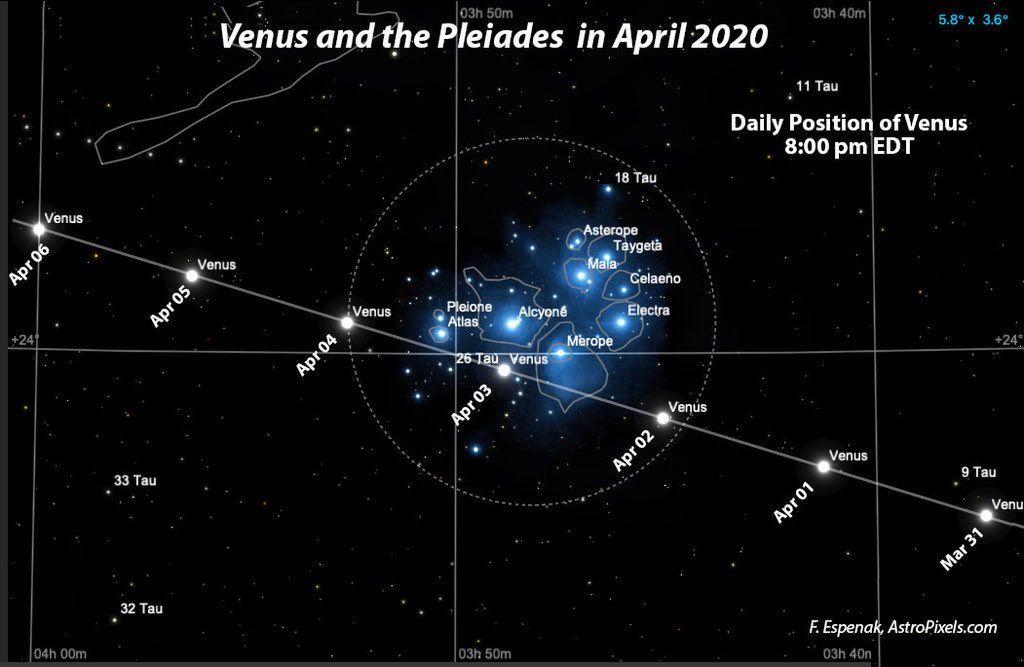So, who’s up for borrowing a trick from @esagaia & measuring the distance to Venus tonight as it glides past the Pleiades?
Challenging, but may be possible. More in the thread below https://abs.twimg.com/emoji/v2/... draggable="false" alt="⬇️" title="Downwards arrow" aria-label="Emoji: Downwards arrow">
https://abs.twimg.com/emoji/v2/... draggable="false" alt="⬇️" title="Downwards arrow" aria-label="Emoji: Downwards arrow">
1/
Challenging, but may be possible. More in the thread below
1/
Here& #39;s how. @esagaia uses parallax to measure the distances to stars & other sources in our Milky Way galaxy & beyond. That is, there& #39;s a slight shift in the position of a relatively star against the distant background as Gaia moves around the Sun.
2/
2/
The bigger the shift, the closer the nearby star is. You can see this effect by holding one of your thumbs out in front of you & seeing it move against the background as you use one eye & then the other. Move your thumb closer & the shift gets bigger.
3/
3/
You can work out the distance to your thumb by geometry, if you know the distance between your eyes & the angular shift your thumb makes against the background. Same with stars: if you know the baseline between measurements & the shift angle, you can calculate the distance.
4/
4/
Now, the baseline for Gaia is up to 300 million km, i.e. the diameter of Earth& #39;s orbit around the Sun (Gaia orbits around the Sun-Earth L2 point about 1.5 million km from Earth). The nearest star, Proxima Cen, is about 40 trillion km away from us.
5/
5/
If you do the maths, that means Proxima Cen will wobble back & forth against more distant stars by about 0.00043 degrees or 1.5 arcseconds. It& #39;s a bit (!) more complicated than that, but I& #39;ll leave you to explore the @esagaia website for more info.
https://sci.esa.int/web/gaia
6/">https://sci.esa.int/web/gaia&...
https://sci.esa.int/web/gaia
6/">https://sci.esa.int/web/gaia&...
OK, great, but what does that have to do with Venus & the Pleiades? Well, Venus is much closer to the Earth than the Pleiades star cluster is, so it too will show some parallax shift if observed from different places. Question is, can we measure it?
7/
7/
Venus is around 100 million km from Earth at the moment, plus or minus, & let& #39;s assume that the Pleiades are so much further away, that they& #39;re fixed. How far apart do two observations need to be for Venus to show (say) a parallax shift of 1 arcsecond against the Pleiades?
8/
8/
Turns out that it& #39;s about 500 kilometres (it& #39;s simply calculated as 10^8/206265  https://abs.twimg.com/emoji/v2/... draggable="false" alt="🙂" title="Slightly smiling face" aria-label="Emoji: Slightly smiling face">). So, two observations taken simultaneously (& I& #39;ll come back to that) 500 kilometres apart on the Earth, should show a shift in the position of Venus against the Pleiades of 1 arcsec.
https://abs.twimg.com/emoji/v2/... draggable="false" alt="🙂" title="Slightly smiling face" aria-label="Emoji: Slightly smiling face">). So, two observations taken simultaneously (& I& #39;ll come back to that) 500 kilometres apart on the Earth, should show a shift in the position of Venus against the Pleiades of 1 arcsec.
9/
9/
Now that& #39;s pretty small, but the parallax shift goes up linearly with the baseline. So over 1000km, e.g. across Western Europe, the shift will be 2 arcsec & over 5,000km, e.g. across the Atlantic, it& #39;ll be 10 arcsec. I reckon that should be measurable in amateur imagery.
10/
10/
However, the key thing is to compare images taken simultaneously. After all, Venus is moving across the sky relative to the Pleiades at about 1 degree/day or 10 arcsec every 4 minutes.
11/
11/
Now, taking pictures between locations to much better accuracy than that should be easily possible if your phone is sync& #39;d to an atomic clock time server (which it probably is). I use the Gorgy Timing Atomic Clock app on my iPhone to display the time accurately, for example.
12/
12/
Given clear skies, people separated by 1,000km in Western Europe will able to see Venus & the Pleiades simultaneously in the dark tonight, giving a parallax shift of 2 arcsec.
13/
13/
It& #39;ll be more challenging across the 5,000km & 5-6 hours of time difference of the Atlantic to yield a 10 arcsec shift. Will Venus still be visible near the horizon as the skies grow dark on the US East Coast? Tricky, even with Venus near maximum elongation around now.
14/
14/
For me, this may all be academic as it& #39;s almost completely overcast here in The Netherlands at the moment  https://abs.twimg.com/emoji/v2/... draggable="false" alt="🤷♂️" title="Man shrugging" aria-label="Emoji: Man shrugging"> But I& #39;d be interested to hear if some people give this a shot tonight. How about exactly at the top of each hour for simultaneity when it& #39;s dark & Venus is visible?
https://abs.twimg.com/emoji/v2/... draggable="false" alt="🤷♂️" title="Man shrugging" aria-label="Emoji: Man shrugging"> But I& #39;d be interested to hear if some people give this a shot tonight. How about exactly at the top of each hour for simultaneity when it& #39;s dark & Venus is visible?
15/
15/

 Read on Twitter
Read on Twitter 1/" title="So, who’s up for borrowing a trick from @esagaia & measuring the distance to Venus tonight as it glides past the Pleiades? Challenging, but may be possible. More in the thread below https://abs.twimg.com/emoji/v2/... draggable="false" alt="⬇️" title="Downwards arrow" aria-label="Emoji: Downwards arrow">1/" class="img-responsive" style="max-width:100%;"/>
1/" title="So, who’s up for borrowing a trick from @esagaia & measuring the distance to Venus tonight as it glides past the Pleiades? Challenging, but may be possible. More in the thread below https://abs.twimg.com/emoji/v2/... draggable="false" alt="⬇️" title="Downwards arrow" aria-label="Emoji: Downwards arrow">1/" class="img-responsive" style="max-width:100%;"/>


